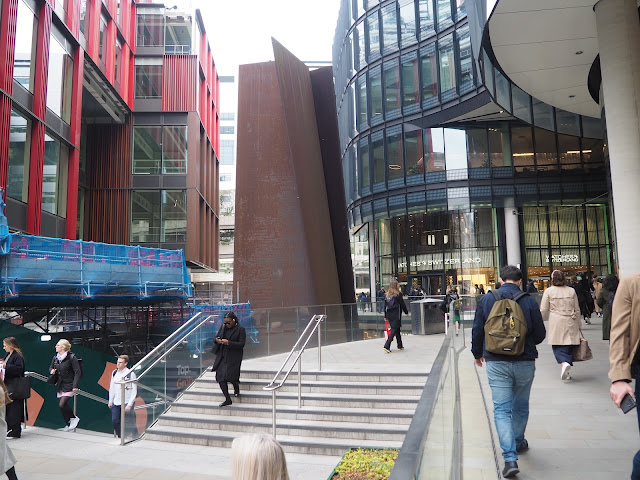 |
| Photo from the Daily Telegraph's obituary, courtesy the Bax family |
Last week I went to the funeral of Dr Martin Bax, best known in my circle as the editor of the literary magazine Ambit, though I was always well aware that he had a parallel life as a pediatrician with an international reputation. He was one of the first people ever to publish my writing, I worked for Ambit as his prose editor, and in due course we became very good friends. This was the Ambit office:
I had no idea how I was going to feel during the funeral itself, though I knew it would be a difficult day one way or another, and it was some distance from where I live. Getting there would involve a train, Tube, and bus ride so I gave myself all the time in the world, which also meant that there would be time to do some walking, wandering, looking, and thinking about things that might or might not relate to Martin and his departure.
At Liverpool Street station I took a small detour to look at Richard Serra’s giant sculpture Fulcrum, which was installed in 1987, a time when my relationship with Martin was in its very early stages. Fulcrum is a strange, magnificent and uncompromising thing, a visitor from a different dimension yet strangely at home in its environment, officially part of the Broadgate Development. In fact the work seems to be so at home that the people walking by, workers, commuters, builders, pay it next to no attention.
I look the tube to East Finchley and decided to walk up through the suburban streets to St Marylebone Crematorium where Martin’s funeral was to be held. Of course just because you’re in a new place or on the way to an important event, doesn’t mean you forget all your old quotidian interests and mild obsessions, which in my own case includes metal buildings and in East End Rd I saw this fine example, a chapel I suppose, of the kind I’ve often seen in Wales.
At that point I hopped on a bus so that I arrived at the crematorium early enough to have a short walk in the memorial garden, a neatly organized set of beds with low, trimmed hedges.
I thought these were box plants and I happen to know that the world’s box population is being systematically devastated and destroyed by the box tree moth, but the website says the hedges are privet. I hope they’re right.
After the funeral and a small lunch, a few of us walked down to Highgate Cemetery where Martin and his late wife Judy will eventually have a memorial. For now we wandering and looked at graves of the famous, Eric Hobsbawm, Bert Jansch and George Eliot, among them – George Eliot even had an obelisk, and you know probably know that obelisks are among my more major obsessions.
The Highgate cemetery provides many fine examples.
The cemetery is also, perhaps primarily, famous as the resting place of Karl Marx, and you’ve no doubt seen this:
I had assumed this was where the great man was buried, but no, this is only a memorial: Marx and his wife are actually buried nearby in this far more modest grave.
There was also a short detour through Waterlow Park. There seemed to be something poignant, poetic and symbolic about this meandering serpentine mown path, but perhaps, after a funeral all things seem poignant and poetic and symbolic.





















